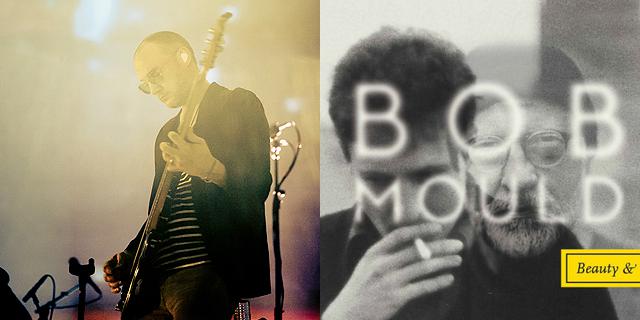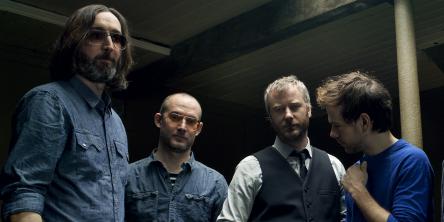I’ve been a fan of Bob Mould’s music for maybe half as long as he’s been making it. In the ’80s when we were in junior high, skateboarding and trying to be punk rock guitar players, I loved the high-velocity, melodic burn of Hüsker Dü, but it was Mould’s 1989 solo album Workbook that I got caught up in emotionally. His account of/reaction to the breakup of Hüsker Dü and his struggle to rebuild and reinvent his music and personal life was a clean-slate, broken-down, acoustic-electric exorcism, delivered with both patience and a burning love/hate delivery. I was lucky enough to see him perform on the Workbook tour at a now defunct club in Columbus, Ohio (embarrassingly, after the show, I asked him to sign my shoe, the best item I could muster), and on the tour for his next album, another favorite, 1990’s Black Sheets of Rain.
I was riveted by Mould’s distinctive voice and signature guitar playing, a melodic malestrom of ringing, jangling chords and searing solos delivered at high volume with massive force through an ’80s Stratocaster with Lace-Sensor pickups. I later sought and (sort of) found a similar guitar, the pickups at least, but it was eventually stolen. (Merci des voleurs rusés français!) Bob Mould made an impression on me — a sort of Pete Townshend and Richard Thompson all rolled into one, for a new era.
I continued to follow Mould’s music with Sugar through college, enjoying his more overtly pop moves in songwriting and production. Then I sort of moved on to other things for a while. (That’s now over 20 years ago — unbelievable.) A couple of years ago, Mould’s fiery album Silver Age came out, and this year Workbook was reissued, snapping me back into Mould-focus and compelling me to catch up with his impressive career and catalogue.
So I was excited to be able to listen to and write about this, Mould’s latest, Beauty & Ruin. It’s a great record, presenting 12 mostly raging reflections on heartache, love, loss and redemption refracted through Mould’s unique black-glass prism of song.
While Workbook was filled with intricate finger-picking, cellos, percussion and strummed defiance, Beauty & Ruin hits with a thick, warm, distorted blast of electric guitar and a rampaging rhythm section. Although both albums seem to look back in anger, Mould’s years (he’s now 53) and experience add a deeper, melancholy glow to Beauty & Ruin, compared to the fresh wounds of Workbook. Still, Mould reminds us here that rage knows no age, and he delivers that news with blunt-force impact.
It begins with “Low Season,” a clanging, churning, dark cauldron of a song with almost Neil Young guitar inflections, searing solos and lyrics like “Low season turn the sunlight down” that find him stuck in a cycle of despair and perhaps some self-destruction to help him along the way. From there, we’re met with the full-throttle “Little Glass Pill,” an indication of the Hüskers-esque punk force that’s to come, with the formidable rhythm section of bassist Jason Narducy and drummer Jon Wurster tearing it up alongside Mould’s raging guitars. Things move along with the poppier “I Don’t Know You Anymore,” reminiscent of Sugar-era Mould and with a typically affecting vocal about a friendship/love affair that ends due to miscommunication, and probably the many other things that can end relationships. “The Kid with the Crooked Face” and “Nemeses Are Laughing” both seem to find Mould darkly reflecting both in lyric and song-style on the choices and behavior of younger days, and the results, or non-results, of them all.
“The War” is one of my favorites on this record — the guitars churn ever upward, rhythm accents and chord strikes emphasizing each beat of Mould’s “after the war” lyrical delivery. The song describes a long and difficult struggle that seems to mirror Mould’s career; it could easily be a personal manifesto, but if it isn’t, it would be a good one: as he sings in the song’s closing lines, “Don’t give up and don’t give in.”
Beauty & Ruin seems to be broken up into four acts — four sections of three songs that seem to grow from the darkness of “Low Season” to the final light of “Fix It,” punctuated by forays into sometimes bleak but ultimately hopeful territory. “Forgiveness” begins the third act (and maybe the second side of the LP) with a break from the heavy sonic attack and a bittersweet lyric about dying plants and a dying relationship. “Hey Mr. Grey” delivers a rapid-fire assault of advice for the title character (who may well be the singer himself) with typical Mouldian sneer. “Fire in the City” and “Tomorrow Morning” hark back to some Hüsker Dü energies and melodic attack, before the almost-campfire song of “Let the Beauty Be” tells the story of a too-pressurized life, acceptance, loss and possibly death, and delivers the “beauty” and “ruin” of the album title.
Finally, not content to leave us acoustically, Mould unleashes “Fix It,” one final blast of melodic fire and a message of self, identity, hope and love. Which seems like a fitting end to Mould’s latest salvo: beauty through pain, light through darkness, keep your head up and struggle through. Thank you, Bob Mould, we will!









